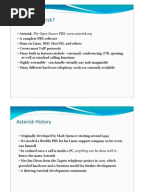Ss7 Protocol Overview Pdf
SS7 Tutorial Tutorial on SS7 Protocol
Dialogic® DSI SS7 Protocols TCAP Programmer's Manual Issue 15 7 1.4 Feature Overview Key features of the TCAP module include: Full implementation of ITU-T Q.771-Q.774 (1992) and ANSI T1.114. Signaling Evolution Overview SS7 Status Sigtran Bearer Independent Call Control Converged Networks NMS Signaling Products. Slide 3 Signaling Evolution Overview. SS7 Protocol Architecture MTP Layer 1 MTP Layer 2 MTP Layer 3 SCCP IS-634/ BSSAP TCAP MSC ANSI-41 HLR GSM MAP INAP/ CAMEL ISUP/ TUP BSS Service Node Transport layers Upper layers. SS7 protocol suite. SCCP completes the functions of the OSI network layer: end-to-end addressing and routing, connectionless messages (UDTs), and management services for users of the Network Service Part (NSP). Telephone User Part (TUP) is a link-by-link signaling system used to connect calls. 4 An Introduction to SS7. SS7 or Signaling System Number 7 is a set of protocols that describes a means of communication between telephone switches in public telephone networks. SS7 is a highly sophisticated and powerful form of Common Channel Signaling (CCS). 03/16/12 Tinniam V Ganesh tvganesh.85@gmail.com SIGNALING SYSTEM 7 (SS7)1 Tinniam.V. SlideShare Explore Search You. SS7 PROTOCOLS 03/16/12SS7 protocols.

This SS7 Tutorial covers SS7 (Signaling System No.7) basics as defined in CCITT. The tutorial on SS7 protocol covers SS7 terminology, SS7 network, SS7 protocol stack, SS7 frame structure and SS7 signal units.

SS7 terminology
Trunk- Interexchange connection is called trunk.
SSP- Signal Switching point, SS7 capable telephone exchange which originate, switch and terminate calls.
STP- Signal Transfer Point, packet switches of the SS7 network, perform routing functions. It allow exchanges to send and receive signaling information from each other.
SCP- Signal Control Point, databases that support advanced call processing functions. Used in free phone services where called party is charged for the call made.
Tandem- Trunk Automatic Exchange, this connects two exchanges which might not have a direct trunk between them.
SS7 network overview
As shown in the figure, typical SS7 network is composed of CO, STP, SCP and tandem. All these entities are interconnected with signaling links, subscriber links and trunks. CO has same functions as SSP. CO has subscriber lines to connect to subscriber, trunk lines to connect to another exchange and signaling lines to connect with STP. Tandem does not have subscriber lines, it has only traffic trunk lines and signaling trunk lines. Let us understand how this works.
Sd gundam g generation world psp iso patch. On the other hand the normal Mobile Suit Gundam video games tend to be of the action type.
- Let us assume that a subscriber in exchange 1 dials a number 1-600-111-123. 1-600 numbers are virtual numbers; they will be mapped to real numbers available and existing.
- When Exchange 1 receives the dialed digits, it decides to send a message to the SCP.
- SCP is the database as mentioned which contains the information as to which number the call should be routed to.
- So the SCP-9 sends a response to 1 through 7 telling 1 to establish a call to 422-4444 which is the actual number that 1-600-111-123 points to.
The main task of carrying traffic is divided into mainly into four phases i.e. idle phase, connection set up phase, transfer phase and release phase. To make connection setup successful, network should have following.
-Identifying off-hook signal from calling party.
-Send calling subscriber dial tone, which indicates that telephone number can be dialed as the line is healthy.
-Receiving the digits of called subscriber.
SS7 protocol stack
SS7 protocol stack composed of following layers/levels.
Physical layer (layer1) - uses time slot no.16 in the case of PCM-30 (2.048 Mbps) and time slot no. 24 in PCM-24 (1.544 Mbps).
Data link layer (layer2) - performs functions such as error control, flow control, link initialization and more.
Signaling network layer (layer3) - At this layer, each node will have 14 bit address, known as signal point code. Each message exchanged will have source and destination codes.
Layer 1 to 3 together forms MTP (Message Transfer Part).
Layer 4 or level 4 is called as User part. MTP supports many different user parts. There are three main user parts which include TUP (telephone User Part), DUP (Data UP) and ISDN-UP.
SCCP (Signaling Connection Control Part) has been added to level 3 to make compatible to layer-4 of OSI protocol stack.
ISP (Intermediate Service Part) performs functions similar to OSI layer 4 to layer 6. TCAP (Transaction Capabilities Application Part) performs functions similar to OSI layer 7.
SS7 Frame structure-HDLC
Layer 2 protocol in SS7 follows HDLC frame format in the order as mentioned below.
Beginning Flag- 1 octet long, unique pattern 01111110, used to define start of the HDLC frame. Mainly used for synchronization purpose. Bit stuffing and un-stuffing concept is used to avoid misinterpreting the information having same pattern.
Address- 1 or 2 octets long,
Control- 1 octet long,
Information- variable length,
Check- 2 octets long, this field helps detect the error in the frame and hence can request for re-transmission if frame received is in error.
End Flag- 1 octet long, , unique pattern 01111110, used to define end of the HDLC frame
How To Use Ss7
SS7 signal units
Information which need to be transmitted by layer-2/level-2 is framed as SU(signal unit). SU follows HDLC frame format as mentioned above. There are three SU types.
MSU- Message Signal Unit, transfers information provided by UP via signalling network level at layer3.
LSSU- Link Status Signal Unit, performs initialization of link and flow control.
FISU- Fill in Signal Unit, used for alignment maintenance when no signal traffic.